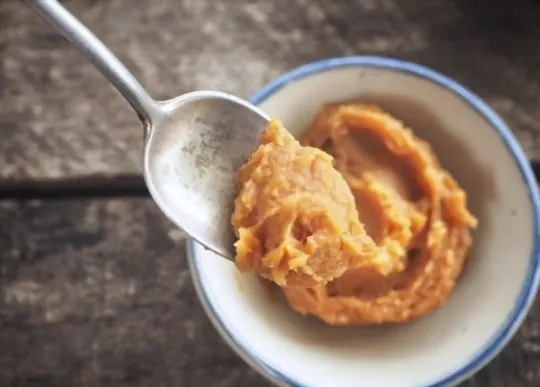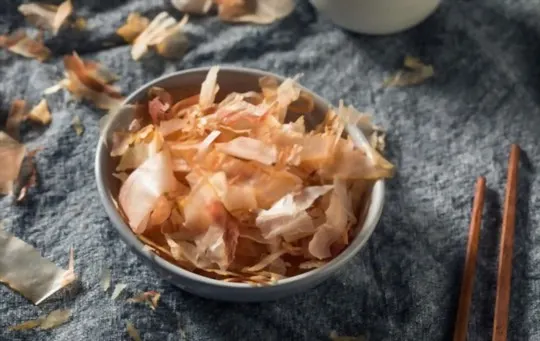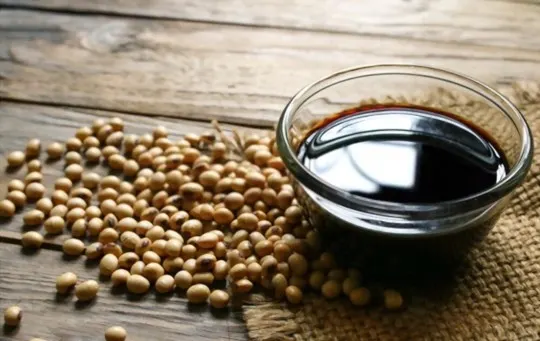Savoring the sea doesn’t always mean sticking to the same old ingredients.
Sometimes, we gotta mix things up a bit.
Finding a substitute for shrimp paste might seem like a tall order.
Lucky for us, the kitchen is a place of creativity and invention.
There are plenty of alternatives that can bring that umami punch to your dishes.
We’ve dived deep into the pantry to pull out the five best swaps you need to know about.
It’s not about replacing; it’s about reimagining flavors.
And trust us, these substitutes are easy to find and even easier to use.
Get ready to give your seafood dishes a twist that’ll surprise and satisfy.
What is Shrimp Paste?

First of all, shrimp paste is a condiment from Asian cuisine.
Shrimp paste smells incredibly strong and can often be off-putting to people who are not used to the smell.
In comparison, it has a much more unpleasant odor than garlic or onion.
The paste is made from small shrimps, or krill, boiled and mixed with salt.
It is then left to ferment for a few days.
Afterward, it is grounded up and some water before being shaped into balls or blocks.
Shrimp paste is an important ingredient in many Southeast Asian cuisines, such as Malaysian, Vietnamese, Thai, and Indonesian cuisine.
Many dishes from these countries feature shrimp paste in their ingredient list, for example, laksa, a spicy noodle soup.
The paste is arguably best enjoyed when cooked with other ingredients.
It has a strong, pungent taste and smell, so it can overpower a dish if not used in moderation.
The 5 Best Substitutes for Shrimp Paste
Shrimp paste is a popular ingredient in many Southeast Asian cuisines, known for its intense umami flavor.
However, if you’re looking for alternatives to shrimp paste due to dietary restrictions or personal preferences, there are several substitutes available that can provide similar characteristics.
In this guide, we will explore the top 5 substitutes for shrimp paste, comparing their key characteristics and providing suggestions on proper ratios to ensure the best results in your recipes.
| Substitute | Key Characteristics | Proper Ratio |
|---|---|---|
| Anchovies | Salty and flavorful fish with a distinct umami taste | Use 1 mashed anchovy fillet for every tablespoon of shrimp paste |
| Fish Sauce | Salty and savory sauce made from fermented fish | Use 1 tablespoon of fish sauce for every tablespoon of shrimp paste |
| Miso Paste | Fermented soybean paste with a rich, savory flavor | Use 1 tablespoon of miso paste for every tablespoon of shrimp paste |
| Bonito Flakes | Dried and smoked flakes of bonito fish, delivering umami notes | Use 1 tablespoon of bonito flakes for every tablespoon of shrimp paste |
| Soy Sauce | Savory and salty sauce made from fermented soybeans | Use 1 tablespoon of soy sauce for every tablespoon of shrimp paste |
Now let’s dive into each substitute in more detail:
1 – Anchovies

Another shrimp paste substitute is Anchovy.
This fish has a strong flavor and smell, but it’s considered delicious in many cuisines.
The Romans ate anchovies by the barrel-load, and they were one of the only foods they would serve fresh rather than pickled or salted.
Today, we can enjoy them topping on pizza or as part of a salad dressing.
The fish is typically preserved, which means they are packed in salt or oil.
After that, you can enjoy them topping on pizzas or salads.
You might be able to find anchovies at a specialty store near you.
However, it is more likely that you will have to order them online.
Make sure they’re packaged in salt and not oil.
- Key Characteristics: Anchovies are small, flavorful fish known for their salty and distinct umami taste. They can be mashed and used as a substitute for shrimp paste, adding depth to your dishes.
- Proper Ratio: Use 1 mashed anchovy fillet for every tablespoon of shrimp paste in your recipe. Adjust the quantity based on your taste preferences.
2 – Fish Sauce

Another popular shrimp paste substitute is fish sauce.
This type of sauce can be used in a wide range of dishes, and this condiment has a long history.
In addition, the Vietnamese have been using the fish sauce for at least 2000 years.
Fish sauce is typically made from fermented anchovies and saltwater, and other ingredients such as sugar or spices.
It’s regarded as an extremely flavorful sauce with high salt content.
Some varieties can be quite spicy too. However, fish sauce is typically used sparingly in dishes.
This condiment is incredibly potent, so it’s useful to keep this substitute on hand if you eat a lot of Asian cuisines.
- Key Characteristics: Fish sauce is a savory and salty sauce made from fermented fish. It provides a similar umami flavor to shrimp paste and can be used as a substitute in various recipes.
- Proper Ratio: Use 1 tablespoon of fish sauce for every tablespoon of shrimp paste. Adjust the quantity based on your recipe’s requirements.
3 – Miso Paste

If you have a food intolerance or want to try something different, miso paste is a great substitute for shrimp paste.
Miso paste is a rich condiment typically made from fermented soybeans and salt.
In addition, miso can vary in color from white to dark brown, with the darker varieties having more intense flavors.
Finally, this paste can be used in many dishes, but it’s most commonly enjoyed as part of miso soup.
Many people swear by miso paste as a shrimp substitute because it has a subtle flavor.
It is also versatile, and you can use this condiment in several dishes.
Lastly, miso paste contains high protein levels, which means you won’t have to worry about any essential amino acids missing from your meals.
- Key Characteristics: Miso paste is a fermented soybean paste with a rich, savory flavor. While not identical to shrimp paste, it offers an umami depth that can enhance your dishes as a substitute.
- Proper Ratio: Use 1 tablespoon of miso paste for every tablespoon of shrimp paste. Adjust the quantity based on your recipe’s requirements.
4 – Bonito Flakes

These flakes are made from dried, fermented, and smoked skipjack tuna.
The fish is typically boiled before being moved to the oven, where the smoking process occurs.
Unlike shrimp paste, bonito flakes don’t have a very strong odor or taste.
However, they can be used as an alternative for this condiment because the flakes dissolve easily.
When using bonito flakes as a substitute, you only need to use a small condiment.
Bonito flakes can be found at most stores that sell miscellaneous dry goods.
These flakes are also used as ingredients in recipes, such as dashi, a traditional Japanese broth.
- Key Characteristics: Bonito flakes are dried and smoked flakes of bonito fish, known for their umami notes. They can add a savory element as a substitute for shrimp paste in certain recipes.
- Proper Ratio: Use 1 tablespoon of bonito flakes for every tablespoon of shrimp paste. Adjust the quantity based on your recipe’s requirements.
5 – Soy Sauce

It’s no surprise that soy sauce is the final shrimp paste substitute.
This condiment has been used in Asian cuisine for at least 2000 years.
Many people say that miso soup wouldn’t be as flavorful without soy sauce.
The reason behind this condiment’s popularity is that it can add a lot of flavor to food.
Soy sauce is typically made from water, soybeans, wheat, salt and has a high sodium content.
It can be used as a dipping sauce or as an accompaniment to sushi dishes.
Soy sauce is typically made in Asia, and very few companies make it outside of Asia.
However, you can find this condiment at most grocery stores.
Also, soy sauce is a great source of protein, and it’s low in fat, so the condiment is popular among those trying to lose a few pounds.
- Key Characteristics: Soy sauce is a well-known savory and salty sauce made from fermented soybeans. While not an exact substitute, it can provide a similar depth of flavor as shrimp paste in some dishes.
- Proper Ratio: Use 1 tablespoon of soy sauce for every tablespoon of shrimp paste. Adjust the quantity based on your recipe’s requirements.
Conclusion
Shrimp paste is quite common in Southeast Asian cuisine, but many people don’t know how to substitute this condiment.
Fortunately, there are several substitutes that you can use if you want to avoid using shrimp paste.
These substitutes typically have similar flavors and textures, so they will help you get your favorite dishes back on the table quickly.
After reading this article, you should have a better idea of which ingredients you can substitute for shrimp paste.

The 5 Best Substitutes for Shrimp Paste
Ingredients
- Anchovies
- Fish Sauce
- Miso Paste
- Bonito Flakes
- Soy Sauce
Instructions
- Pick your favorite substitute from the list above.
- Follow cooking directions for your selected substitute with the proper ratio of ingredients.

Andrew Gray is a seasoned food writer and blogger with a wealth of experience in the restaurant and catering industries. With a passion for all things delicious, Andrew has honed his culinary expertise through his work as a personal chef and caterer.
His love for food led him to venture into food writing, where he has contributed to various online publications, sharing his knowledge and insights on the culinary world. As the proud owner of AmericasRestaurant.com, Andrew covers a wide range of topics, including recipes, restaurant reviews, product recommendations, and culinary tips.
Through his website, he aims to inspire and educate fellow food enthusiasts, offering a comprehensive resource for all things food-related.

Leave a comment